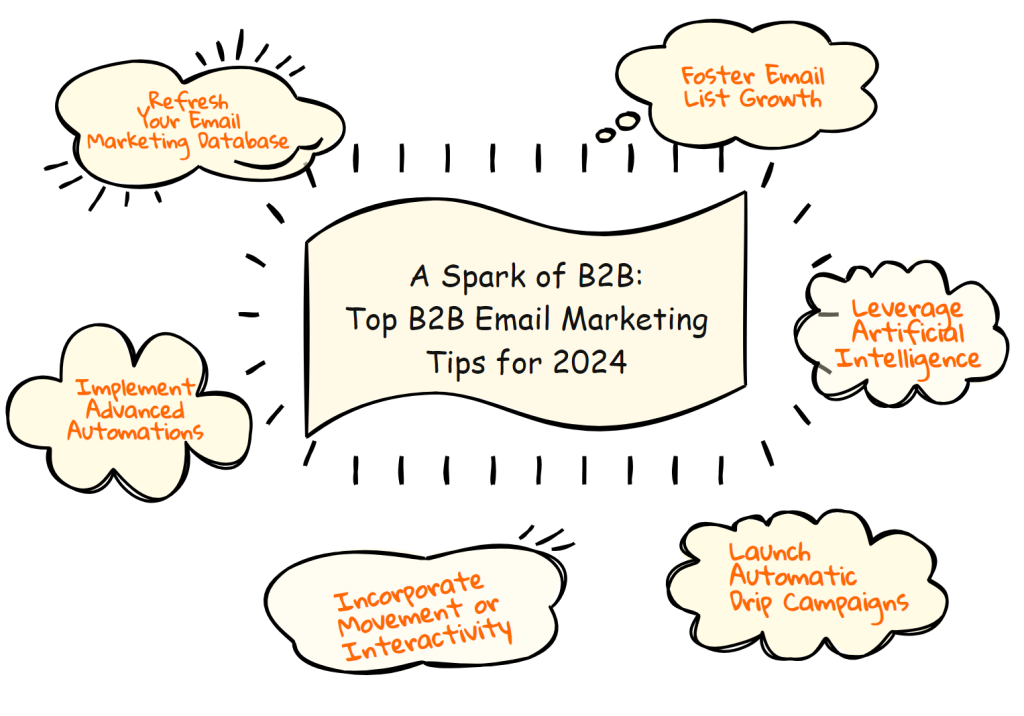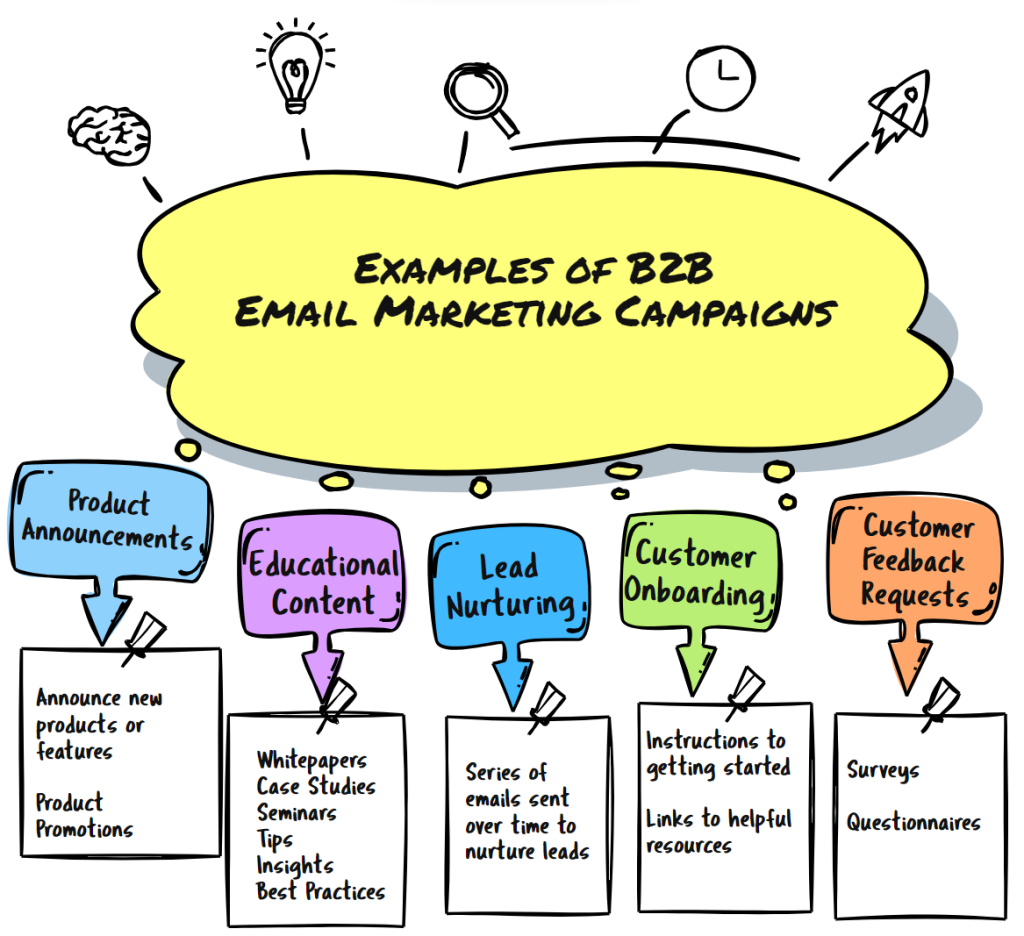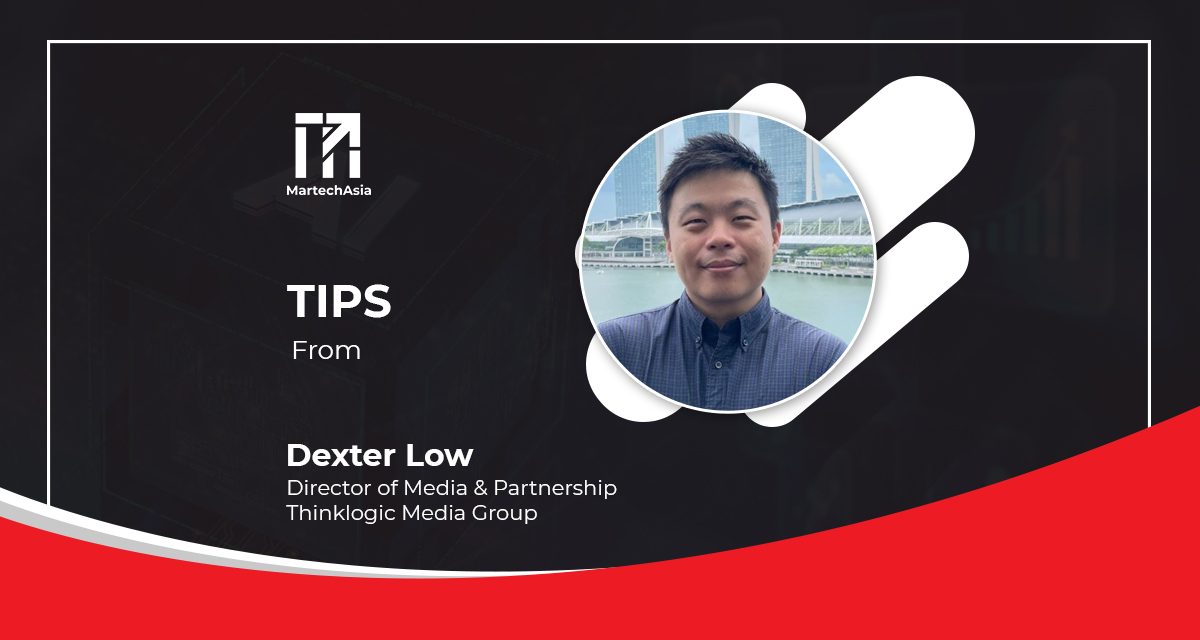The year 2024 has plunged businesses into the age of AI. As a marketer, you need to ask yourself this: How will you implement your B2B email marketing campaign to make this year a phenomenal success?
Even in the age of AI, email marketing remains one of the most cost-effective digital marketing channels for B2B businesses. By taking advantage of the latest tips and strategies, businesses of all sizes can improve the ROI of your email campaigns and achieve better results for your marketing dollars.
The fact is, effective email marketing allows businesses to stay top-of-mind, slowly nurture leads over time, and remind your clients and leads of their ongoing need for support and assistance as they navigate their challenges and opportunities. When we put the customer first in our communication strategies, we drive more conversions and have what it takes to forge the kind of lasting partnerships that drive our mutual success.

1. Refresh your email marketing database
When seeking to enhance your email marketing strategy, a valuable initiative is to refresh your contacts within your customer relationship management (CRM). Segmenting email lists and eliminating low-quality leads is an excellent starting point. By categorizing contacts based on factors like industry, company size, or engagement history, you can tailor your messaging to suit the specific needs of your audience.
Additionally, removing contacts that no longer align with your target audience or demonstrate minimal interest can create space for higher-quality prospects. Once your CRM is optimized, you can focus on engaging with groups genuinely interested in your offerings, thus maximizing the effectiveness of your email marketing campaigns.
2. Foster email list growth
In B2B email marketing, the primary goal is to deliver valuable insights to stakeholders. This can encompass industry updates, client success stories (with appropriate permissions), and detailed product or service specifications. The overarching aim is to provide assistance and aid potential clients in discerning their company’s needs. One of the most effective strategies for expanding your email list involves offering valuable content in exchange for a subscription.
A proven approach is to utilize lead magnets, such as white papers. SuperOffice indicates that 36% of B2B decision-makers turn to white papers at the outset of the purchasing process. These documents inform decision-makers and their teams about available solutions in the market. By presenting detailed specifications, white papers enable comparison with corporate requirements and help justify the investment as essential. Incorporating compelling lead magnets like white papers can significantly boost email list growth while providing valuable resources to potential clients.
3. Leverage AI
AI-driven email marketing platforms can analyze vast amounts of data to personalize email content, subject lines, and send times for each recipient, leading to higher open rates and engagement. Moreover, AI algorithms can predict customer behavior and preferences, allowing marketers to tailor their email campaigns more effectively.
For B2B marketers, AI-powered email marketing tools can provide insights into industry trends, segment audiences based on their preferences and behaviors, and suggest relevant content topics. This helps B2B marketers create more targeted and impactful email campaigns that resonate with their business audience.
4. Incorporate movement or interactivity
In B2B email marketing, incorporating movement or interactivity can elevate engagement and capture the attention of recipients. By integrating video links or animated GIFs, marketers can create an immersive experience that sparks curiosity. Product photography can be leveraged to showcase features through subtle animation, directing the reader’s focus to key selling points.
Incorporating gamification into B2B email marketing can add interactivity and engagement, making emails more memorable and effective. Interactive quizzes or surveys related to industry or products can encourage participation with incentives or rewards. Progress bars or milestones can track engagement achievements, like completing purchases or referrals. Challenges or competitions can prompt recipients to compete or collaborate for prizes or recognition.
Interactive content, such as clickable images or flip cards, can enhance engagement. Hosting virtual events or webinars with live interactions provides additional value. Implementing reward programs where recipients earn points or rewards for various actions incentivizes engagement and encourages repeat interactions. These strategies enhance engagement, foster stronger connections, and drive desired actions for business growth.
5. Implement advanced automation
In B2B email marketing, it’s imperative to establish sophisticated automation processes tailored to the customer journey. These automation should seamlessly guide prospects from their initial inquiry to ongoing purchases. A crucial aspect involves sending out automated emails triggered by specific customer behaviors, aimed at encouraging conversion.
One essential automation is the Lead Magnet Autoresponder, which promptly sends tailored emails to customers who engage with lead magnet activities, such as downloading white papers or filling out response cards. The primary objective of these autoresponders is to initiate and nurture relationships with prospects, fostering engagement and paving the way for potential conversions.
6. Launch automatic drip campaigns
Sending a single email is unlikely to result in product sales, especially in the context of B2B email marketing. To achieve success, automatic drip campaigns are essential. These campaigns deliver regular, tailored information to your sales prospects, increasing the likelihood of conversions.
Creating effective email drip campaigns for B2B marketing involves several key steps. Firstly, define your goals, such as nurturing leads, driving sales, or providing education. Segment your audience based on factors like industry, job title, or stage in the sales funnel to tailor messages to specific needs. Plan your content sequence, deciding what to send in each email and the order.
Choose an email automation tool like Mailchimp or HubSpot supporting drip campaigns. Craft compelling emails with engaging subject lines and personalized content to increase relevance. Set up trigger points to initiate email sends based on recipient actions or dates. Test and optimize your campaign through A/B testing and monitoring performance metrics.
Examples of B2B email marketing campaigns

In a landscape where consumer behavior, technology, and regulations are in constant flux, the imperative for B2B marketers to adapt their email marketing strategies is unequivocal. In the age of AI, this isn’t merely a suggestion but a necessity for staying ahead in the race.
By embracing innovation, respecting data privacy, and harnessing the power of AI, marketers can weave a narrative that resonates deeply with their audiences, forging stronger connections and propelling business growth into the future. In this era of evolution, the penultimate key to success lies in the willingness to evolve with it.


















